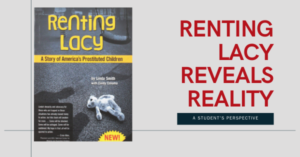
I was assignment to read Renting Lacy for a class on human trafficking at my university. Renting Lacy was a required book for the course. Though it was a quick read, it was notably substantive.
Renting Lacy is a fictional, yet reality-based story founded upon the biographies of the unfortunate lives that are involved in the child sex trafficking network in the United States.
The novel depicts a story of an underage girl and her co-workers who are trapped in a sex trafficking ring in Las Vegas. Lacy has been a victim of sex trafficking from a very young age and has been loyal to her trafficker, Bobby Bad, for many years now. She manages and cares for the other girls, Star, Sugar, Cherry, Brandi, and KiKi, who are stuck in her same situation. The book explains how Bobby grooms vulnerable girls by using love, affection, and gifts. Once they are hooked on him and the drugs he supplies, he detracts, leaving them wanting more. This is when he knows they will do anything for him, something even as dehumanizing as selling sex for money. Yet, they all feel a sense of loyalty and even fear towards him.
The mental torment, deceit, and violation the girls endure has left an immeasurable impact on me. Even more so, knowing that even though the book is a compilation of replicated accounts, these intertwining stories are consistent with the real life experiences of individuals manipulated into sex trafficking.
A unique aspect of Renting Lacy is the comprehensive approach to defining, analyzing, and understanding the dynamics of a trafficking situation. Not only is the story told through the dialogue of traffickers and the targeted girls themselves, but of police officers, judges, family members, buyers, and sellers that are included as well. This is illuminating because there is so much value in the awareness of multiple perspectives in regards to the study of sex trafficking.
This book is raw, explicit and devastating, but it tells a strong story that is a solemn reminder of the vulnerabilities of our youth. It is a story that needed to be told to really grasp the interconnectedness and intersectional issues that are presented on this topic. The interwoven events of being trafficked and also being forced to engage in the victimization of others results in compounded trauma. For many of the girls in the book, the victim-offender intersections of their experiences makes the girls’ situation that much more complex. This leads them to be identified as criminal, rather than victim. Shared Hope released a report on this very issue in January that you can read here.
I am glad I got the opportunity to cross paths with Renting Lacy and take from it the knowledge and awareness of an issue that is happening all around us. It forced me to take a hard look at the world around me, instead of brushing off this topic as ‘someone else’s issue’. It is all of our problems and we are all part of the solution. This is an important book for future students to read, as well, because is motivates a discussion of the reality of sex trafficking. Renting Lacy is a humbling book that has the ability to spark initiative.






